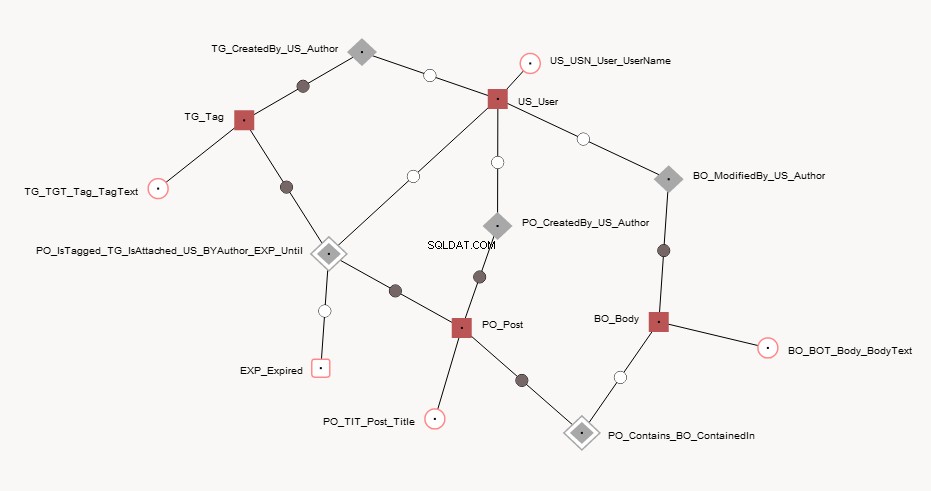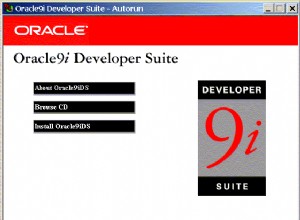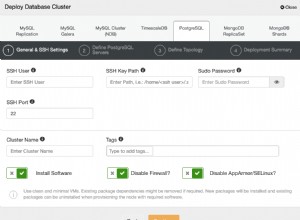Mô hình neo là một cách hay để triển khai dB tạm thời - xem bài viết trên Wikipedia Cũng cần một thời gian để làm quen, nhưng hoạt động tốt. Có một công cụ lập mô hình trực tuyến và nếu bạn tải tệp XML được cung cấp [File -> Load Model from Local File] bạn sẽ thấy một cái gì đó như thế này - cũng sử dụng [Layout --> Togle Names] .

[Generate --> SQL Code] sẽ tạo DDL cho các bảng, khung nhìn và các hàm theo thời gian. Đoạn mã này khá dài nên tôi không đăng nó ở đây. Kiểm tra mã - bạn có thể cần sửa đổi mã cho DB của mình.
Đây là tệp để tải vào công cụ tạo mô hình.
<schema>
<knot mnemonic="EXP" descriptor="Expired" identity="smallint" dataRange="char(1)">
<identity generator="true"/>
<layout x="713.96" y="511.22" fixed="true"/>
</knot>
<anchor mnemonic="US" descriptor="User" identity="int">
<identity generator="true"/>
<attribute mnemonic="USN" descriptor="UserName" dataRange="varchar(32)">
<layout x="923.38" y="206.54" fixed="true"/>
</attribute>
<layout x="891.00" y="242.00" fixed="true"/>
</anchor>
<anchor mnemonic="PO" descriptor="Post" identity="int">
<identity generator="true"/>
<attribute mnemonic="TIT" descriptor="Title" dataRange="varchar(2)">
<layout x="828.00" y="562.00" fixed="true"/>
</attribute>
<layout x="855.00" y="471.00" fixed="true"/>
</anchor>
<anchor mnemonic="TG" descriptor="Tag" identity="int">
<identity generator="true"/>
<attribute mnemonic="TGT" descriptor="TagText" dataRange="varchar(32)">
<layout x="551.26" y="331.69" fixed="true"/>
</attribute>
<layout x="637.29" y="263.43" fixed="true"/>
</anchor>
<anchor mnemonic="BO" descriptor="Body" identity="int">
<identity generator="true"/>
<attribute mnemonic="BOT" descriptor="BodyText" dataRange="varchar(max)">
<layout x="1161.00" y="491.00" fixed="true"/>
</attribute>
<layout x="1052.00" y="465.00" fixed="true"/>
</anchor>
<tie timeRange="datetime">
<anchorRole role="IsTagged" type="PO" identifier="true"/>
<anchorRole role="IsAttached" type="TG" identifier="true"/>
<anchorRole role="BYAuthor" type="US" identifier="false"/>
<knotRole role="Until" type="EXP" identifier="false"/>
<layout x="722.00" y="397.00" fixed="true"/>
</tie>
<tie timeRange="datetime">
<anchorRole role="Contains" type="PO" identifier="true"/>
<anchorRole role="ContainedIn" type="BO" identifier="false"/>
<layout x="975.00" y="576.00" fixed="true"/>
</tie>
<tie>
<anchorRole role="CreatedBy" type="TG" identifier="true"/>
<anchorRole role="Author" type="US" identifier="false"/>
<layout x="755.10" y="195.17" fixed="true"/>
</tie>
<tie>
<anchorRole role="CreatedBy" type="PO" identifier="true"/>
<anchorRole role="Author" type="US" identifier="false"/>
<layout x="890.69" y="369.09" fixed="true"/>
</tie>
<tie>
<anchorRole role="ModifiedBy" type="BO" identifier="true"/>
<anchorRole role="Author" type="US" identifier="false"/>
<layout x="1061.81" y="322.34" fixed="true"/>
</tie>
</schema>




